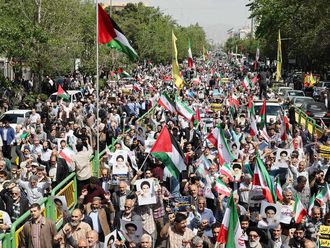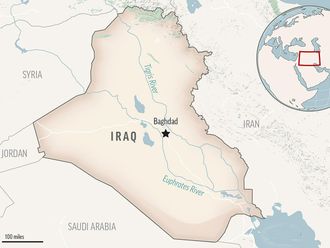Dubai: Mohammad Zeidan was one of the survivors of the Deir Yassin Massacre on April 9, 1948, when nearly 100 Zionist terrorist groups from the Irgun and Lehi attacked the placid Palestinian village of 600 people.
Dozens were killed.
Zeidan, then a young boy, received several bullet injuries. He was lucky to survive, as he had hidden under a pile of straw. He lived with a bullet stuck in his lung, until his death a few years ago. He used to tell his story to his colleagues, including myself. He said he lost his mother and all his siblings in the massacre, while his father was away. Zeidan was rescued from under the rubble, and was sent to a church-run orphanage run in occupied East Jerusalem. Two years later, his father found him.
Zeidan’s is just one of the myriad stories of Palestinians whose world changed when their homeland was turned into Israel after the first Arab-Israeli war.
The year 1948 was a ‘decisive’ one in Palestinian history.
Before the war, Arabs were the majority in historical Palestine, estimated at 1.4 million out of a population of two million. They owned nearly 90 per cent of the private land, according to researchers.
“Over a period of only a few months, as war in Palestine escalated from March until October 1948, a striking transformation took place,” wrote prominent Palestinian-American historian and academic Rashid Al Khalidi in his book ‘The Iron Cage’.
“More than half of the country’s Arab majority, probably over the 750,000 people, were expelled from or forced to flee the areas that became part of the State of Israel. About half were obliged to depart from their homes before the formal establishment of Israel and the entry of several Arab armies into Palestine on May 15, the rest left after that date,” Khalidi wrote.
Those who left became refugees in Lebanon, Syria, and the West Bank, which was under the Jordanian rule, or the Gaza Strip, which was under Egyptian rule. Some Palestinians went to places further afield.
Nearly 150,000 Palestinians remained in their cities, which ended up becoming part of Israel, falling within its borders. Today, Israel controls almost 78 per cent of the historical, British-mandate Palestine, rather than the 55 per cent allotted for the Jewish state as per the 1947 partition plan, Al Khalidi said.
While Israel uses the term “transfer”, Palestinians use the term “ethnic cleansing” for what happened in 1948.
The issue of refugees was among the most difficult topics of negotiations before the peace talks collapsed after US President Donald Trump’s announcement declaring occupied Jerusalem as the capital of Israel.
However, the international community acknowledged the rights of the 1948 Palestinian refugees in UN resolution 194, which gives them the choice between return or being compensated for the loss or the damage to their properties.
“By the end of 1948, a majority of the Arab urban population of Palestine, the best educated, the wealthiest, and the most culturally active, had lost their properties and become refugees,” Al Khalidi said.
The Palestinian refugees came from Lydda, Ramleh, Acre, Safad, Tiberias, Beisan and Bir Sabe’, and scores of villages around those cities and towns.
Israel denies any responsibility for the Palestinian exodus, claiming it was the Arab leaders who told the Palestinians to flee.
However, historians, researchers and political scientists have challenged the Israeli narrative.
Jewish terror groups, including the Irgun and Lehi, launched several attacks against civilians and Arab military targets in different parts of historical Palestine. They also terrorised the Arabs by attacking unarmed Palestinian villagers and murdering them during the few months before the establishment of Israel in May 1948.
The British mandate authorities also played a role in influencing the course of events, either as a result of their sudden withdrawal from cities and “inviting” Jewish militias to take over, or by ignoring Palestinian appeals for intervention and protection, according to another prominent Palestinian-American historian Walid Al Khalidi.
“They are shown, inter alia, suspending democracy, rejecting petitions, ignoring the appeals of delegations, and disregarding the resolutions of the Palestine National Congresses and the recommendations of their own expert commissions of inquiry. They facilitated massive Jewish immigration by force of arms, fired into unarmed crowds of civilians, and rained baton blows on the head of the grand old man of Palestinian politics, the eighty-year-old Mousa Kazem Al Hussaini,” wrote Walid Al Khalidi in a paper published in the Journal of Palestine Studies.
The paper, titled “Benny Morris and Before Their Diaspora” came as a response to Morris’s review of Walid Al Khalidi’s book on the Palestinians, “Before Their Diaspora”.
Today, some of Israel’s new historians, using different sources including Israeli archives, are offering new evidence that Israeli attacks were largely to blame for the Palestinian exodus.
“The work of these and other historians indicates that while in a few areas non-combatants were urged by the Palestinian leadership to evacuate their homes for their safety, and some fled before the fighting reached them, most Palestinians left because they were forced to do so either by direct Israeli attacks on their cities and villages or due to conditions of extreme insecurity,” wrote Rashid Al Khalidi in his book.
“Far from telling them to leave, by April 1948 the Palestinian leadership and the Arab governments were so horrified by the flood of refugees that both made fruitless efforts to stem the flow,” he said.












